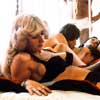 VICE AND VULGARITY PLAY WELL IN AUSTRALIA. With the country's rum-corps origins and epic isolation, low-grade spectacle exuding illegality takes on a certain mythic quality. It’s hardly surprising then that the “great southern land” would have a rich and shameless history of bottom-line exploitation cinema, the glory days of which—the 1970s and ’80s—are affectionately chronicled in Not Quite Hollywood, a second-generation fan’s account of the rise and squall of the seedier side of the Australian film industry. Directed by Melburnian, gen-X music-video impresario Mark Hartley, NQH has no time for cultured, capital-C cinema. Peter Weir be damned. What we have here is the underbelly—cheap thrills devised to populate Australian, and eventually American, drive-in and grindhouse theaters. The story begins with the explosive confluence of freethinking, ’60s radicalism, and a long-overdue slackening of severely repressive censorship laws. With the establishment of the R rating in 1971, the libidinal pressure of generational change popped the cork on local cultural expression with an intoxicating rush of bawdy, self-deprecating comedy (an old-school Aussie specialty). Stork (1971) and The Adventures of Barry McKenzie (1972), both semi-literate, balls-out, satiric offensives against pretense and social convention, were huge hits at the Australian box office. This emboldened despairing young filmmakers and industry hacks alike—previously indentured to the occasional American production that wandered into town—to take up the challenge of telling their own stories, with the express purpose of turning a buck. Inspired one-upmanship, low-budget innovation, smut, death-defying stunts, and horrific visceralia ensued. Hartley’s proficiency at VH1-style narrative montage delivers a highly engaging visual joyride that is punctuated by often-hilarious anecdotal commentaries from key players. In addition to providing a loose but useful chronology of increasingly outrageous cinematic high jinks, the film serves as a kind of synecdoche for a period of intense transformation in Australian society and national character. Eschewing the old inward-looking embrace of hermetic resignation, the boomer culture industry surrendered to a yearning for individualistic latitude and international connection. In NQH, this process of maturation, if you will, moves quickly from the profoundly camp lampooning of “ockerisms” by national treasure Barry Humphries, whose witty eviscerations both on- and off-screen elicit some of the deepest belly laughs to be had here, to the unselfconscious anticipation of lowest-common-denominator taste by the likes of unapologetic T&A peddler John D. Lamond (“it’s contrived, but that doesn’t mean it’s bad”) and prolific storytelling stunt merchant Brian Trenchard-Smith (“action is the universal currency”).
Trenchard-Smith’s violent, muscle-car aesthetic—an Aussie staple—shifts gear with consideration of Kennedy/Miller’s Mad Max (1979), described in the film by George Miller as a “B movie with A-movie aspirations”—an objective spectacularly realized with the film's two sequels. While the trail to international acceptance for Ozploitation was most notably blazed by reputedly sleazy producer Antony I. Ginnane, who, in a bid for US market share and recognition, began employing washed-up Hollywood actors and developing placeless scripts, the success of Mad Max helped pave the way for a new, more worldly group of filmmakers harboring international ambitions. Yet, by the end of the ’80s, the genre-movie industry was beset by problems, principally: a rising tide of cultural self-consciousness (the downside of dressing for success), a tax-break driven glut of execrable movies, the sheer depletion at the reservoir of repression from which the industry had drunk, and the gradual decline of the drive-in theater. Aussie exploitation came a long way in two decades. Despite the comparatively diminished output, Hartley’s generation of film producers now speak of a new wave, represented most forcefully in NQH by Wolf Creek (2005) director Greg Mclean and the very first talking head we encounter—Quentin Tarantino—who goes on to enthuse, madly, throughout. As a pitchman for B-movie validity, Tarantino is gold, and although his performative rhapsodizing often smacks of film-junkie perversity, he makes a convincing case for the expulsive pleasure of sensationalist entertainment. Comically offset here by the blanket, baritone dismissals of Australian author, screenwriter, and critic Bob Ellis—a curmudgeonly caricature of the cultural commentator (pardon the alliteration, it comes with the territory)—the nostalgically starry-eyed underpinnings of this postmodern generation’s appreciation ensure the adoption of this material as a master code for future riffing and homage. In the end, Not Quite Hollywood is for the most part more rewarding than its subject matter, much of which is, despite (spent) moments of delirious purgation, flashes of allegorical brilliance, and earnest attempts at rehabilitation in cultural studies circles, now best consumed in small, well-chosen bites.
|
